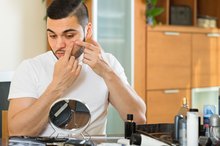What does fact checked mean?
At Healthfully, we strive to deliver objective content that is accurate and up-to-date. Our team periodically reviews articles in order to ensure content quality. The sources cited below consist of evidence from peer-reviewed journals, prominent medical organizations, academic associations, and government data.
- Abdel-Motaleb AA, et al. (2017). Dermal morphological changes following salicylic acid peeling and microdermabrasion. DOI:
- Abels C, et al. (2014). Significant improvement in mild acne following a twice daily application for 6 weeks of an acidic cleansing product (pH 4). DOI:
- Dong J, et al. (2016). Enlarged facial pores: An update on treatments.
- Dong J, et al. (2016). Enlarged facial pores: An update on treatments.
- Draelos ZD. (2006). The effect of a daily facial cleanser for normal to oily skin on the skin barrier of subjects with acne.
- Draelos ZD. (2006). The effect of a daily facial cleanser for normal to oily skin on the skin barrier of subjects with acne.
- Han X, et al. (2017). Antiinflammatory activity of cinnamon (cinnamomum zeylanicum) bark essential oil in a human skin disease model. DOI:
- Jung YR, et al. (2017). Hyaluronic acid decreases lipid synthesis in sebaceous glands. DOI:
The information contained on this site is for informational purposes only, and should not be used as a substitute for the advice of a professional health care provider. Please check with the appropriate physician regarding health questions and concerns. Although we strive to deliver accurate and up-to-date information, no guarantee to that effect is made.
How to Clear Sebum From Pores
Sebum is the filmy, sticky substance produced by the sebaceous glands. These glands often are found in the hair follicles and are responsible for keeping the skin's surface soft by preventing water loss. However, when produced in excess, sebum can cause the skin to appear oily and clog the pores. Too much sebum also can nourish the P. acnes bacteria that lives on the skin, leading to acne lesions, whiteheads and blackheads, according to DERMA Doctor.
**Wash your skin twice daily with an oil-free cleanser 4. DERMA Doctor recommends using a mild cleanser for washing the face, as you may use other products that are aimed at reducing oil on the skin, which can be extremely drying and irritating to the skin. Cleanse in the morning and at night, which can remove accumulated dirt and oil that have built up from the day and clean your skin for the application of a sebum-clearing product 2.
How to Fill in Acne Scars With New-Skin Liquid Bandage
Learn More
Utilize an astringent pad, which can help to reduce the amount of sebum on the skin, according to Medline Plus. An example of a typical astringent used is witch hazel.
Apply a skin treatment product designed to remove sebum from pores. These include products with salicylic acid and benzoyl peroxide, both of which can be purchased over the counter. Salicylic acid encourages exfoliation of the skin's pores by causing excess dirt and oils to slough away. Benzoyl peroxide works to clear sebum by introducing oxygen into the pores, which then flushes sebum out of the pores.
How to Make Face Skin Produce Less Oil
Learn More
Apply an oil-free moisturizer to any areas that show dryness following topical acne applications. Because not every area of your skin produces excess oil, you may find you experience unexpected dryness while working to clear sebum. Common areas of dryness may include the eyebrows, chin and cheeks.
Apply a facial mask once to twice per week in order to allow the mask's ingredients to seep deep into the pores, ridding the skin of excess oils. Examples of sebum-clearing masks ingredients include sulfur, clay or glycolic acid.
Warnings
Refrain from using products that contain oil, as these can further clog the pores and contribute to sebum production. Products that do not contain oil will be labeled as non-comedogenic.
Related Articles
References
- Abdel-Motaleb AA, et al. (2017). Dermal morphological changes following salicylic acid peeling and microdermabrasion. DOI:
- Abels C, et al. (2014). Significant improvement in mild acne following a twice daily application for 6 weeks of an acidic cleansing product (pH 4). DOI:
- Dong J, et al. (2016). Enlarged facial pores: An update on treatments.
- Draelos ZD. (2006). The effect of a daily facial cleanser for normal to oily skin on the skin barrier of subjects with acne.
- Han X, et al. (2017). Antiinflammatory activity of cinnamon (cinnamomum zeylanicum) bark essential oil in a human skin disease model. DOI:
- Han X, et al. (2017). Anti-inflammatory activity of clove (eugenia caryophyllata) essential oil in human dermal fibroblasts. DOI:
- Jung YR, et al. (2017). Hyaluronic acid decreases lipid synthesis in sebaceous glands. DOI:
- Meier L, et al. (2012). Clay jojoba oil facial mask for lesioned skin and mild acne — Results of a prospective, observational pilot study. DOI:
- Fischer H, Fumicz J, Rossiter H, Napirei M, Buchberger M, Tschachler E, Eckhart L. Holocrine Secretion of Sebum Is a Unique DNase2-Dependent Mode of Programmed Cell Death. J Invest Dermatol. 2017;137(3):587-594. doi:10.1016/j.jid.2016.10.017
- Schneider M, Paus R. Sebocytes, multifaceted epithelial cells: lipid production and holocrine secretion. Int J Biochem Cell Biol. 2010;42(2):181-5. doi:10.1016/j.biocel.2010.11.017
- Bagatin E, de Freitas T, Machado M, Ribeiro B, Nunes S, da Rocha M. Adult female acne: a guide to clinical practice. An Bras Dermatol. 2019;94(1): 62–75. doi:10.1590%2Fabd1806-4841.20198203
- Picardo M, Ottaviani M, Camera E, Mastrofrancesco A. Sebaceous gland lipids. Dermatoendocrinol. 2009;1(2):68-71. doi:10.4161%2Fderm.1.2.8472
- Lovászi M, Szegedi A, Zouboulis C, Törőcsik D. Sebaceous-immunobiology is orchestrated by sebum lipids. Dermatoendocrinol. 2017;9(1):e1375636. doi:10.1080/19381980.2017.1375636
- Zhou S, Li D, Zhou Y, Cao J. The skin function: a factor of anti-metabolic syndrome. Diabetol Metab Syndr. 2012;4(1):15. doi:10.1186/1758-5996-4-15
- Fox L, Csongradi C, Aucamp M, Du plessis J, Gerber M. Treatment Modalities for Acne. Molecules. 2016;21(8). doi:10.3390%2Fmolecules21081063
- Osterberg EC, Bernie AM, Ramasamy R. Risks of testosterone replacement therapy in men. Indian J Urol. 2014;30(1):2-7. doi:10.4103/0970-1591.124197
- Endly D, Miller R. Oily Skin: A review of Treatment Options. J Clin Aesthet Dermatol. 2017;10(8):49-55.
- Borda L, Wikramanayake T. Seborrheic Dermatitis and Dandruff: A Comprehensive Review. J Clin Investig Dermatol. 2015;3(2). doi:10.13188/2373-1044.1000019
- Szöllősi A, Oláh A, Bíró T, Tóth B. Recent advances in the endocrinology of the sebaceous gland. Dermatoendocrinol. 2017;9(1):e1361576. doi:10.1080%2F19381980.2017.1361576
- Strumia R. Eating disorders and the skin. Clin Dermatol. 2013;31(1):80-5. doi:10.1016/j.clindermatol.2011.11.011
- Purnamawati S, Indrastuti N, Danarti R, Saefudin T. The role of moisturizers in addressing various kinds of dermatitis: A review. Clin Med Res. 2017;15(3-4):75-87.
Writer Bio
Rachel Nall began writing in 2003. She is a former managing editor for custom health publications, including physician journals. She has written for The Associated Press and "Jezebel," "Charleston," "Chatter" and "Reach" magazines. Nall is currently pursuing her Bachelor of Science in Nursing at the University of Tennessee.









